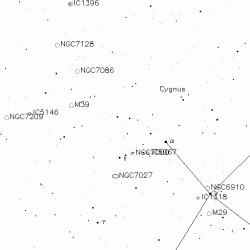Out in the deep reaches of space, a cocoon has formed. Here on Earth, a cocoon represents the casing of a pupae – the child/insect which is about to undergo a magnificent transformation into a beautiful moth or butterfly. So what does the cosmic cocoon, IC 5146, hide inside? Let’s take a look…
Roughly 4000 light years away in some of the richest star fields in the northern Cygnus Milky Way, lies IC 5146. Discovered by Thomas Espin, it has often been referred to as the “Cocoon” because it lay at the end of a long and fairly starless trail – like the proverbial worm who ate its way to the end of the leaf before time for change. Although IC 5146’s fanciful name fits wonderfully with its visual appearance, what you may not know is the moniker is also very indicative of the star-birth process going on inside!
Deep within the folds and rifts of the bright nebula are many regions of emission, absorption and reflection. According to studies done by Kramer (et al), “A submillimeter dust continuum study of a molecular ridge in IC 5146 consists of at least four dense cores which are likely to be prestellar in nature. A map of dust temperatures, constructed from the continuum flux ratios, shows strong temperature gradients. Several cores appear isothermal, while two have inwardly decreasing temperatures profiles, which is expected if the cores are externally heated. We find an inverse correlation which we interpret as signature of grain coagulation and the formation of ice mantles, in accordance with models of dust evolution in dense prestellar cores.”
The embryo is emerging stars.
According to recent measurements, the massive star in the center of the Cocoon opened its way into the existing molecular cloud – the flowing and glowing region also known as Caldwell 19. Even though the central star is perhaps 100,000 years old, it still provides the major energy source of the visible light – but what about what is invisible?
According to W.B. Samson: “The very young star cluster IC 5146 is studied using star counts, with a view to determining the distribution of interstellar matter in a region where star formation recently occurred. IC 5146 is embedded in a dark nebula which is very dense near its center.” A dense center which hides magnetic properties! “Polarization of starlight in IC 5146 is found to be very variable in both magnitude and direction, indicating the presence of complex magnetic fields within the cluster.”
While the dark dust trail of Barnard 168 may appear to be full of nothing – nothing could be further from the truth. According to Lada and Elmegreen: Millimeter-wave observations of the dark cloud complex immediately surrounding the young open cluster IC 5146 show two unusually intense oxygen sources… suggesting the presence of two or more obscured newly formed stars embedded in molecular gas at the periphery. The total mass of the dark cloud complex is estimated to be 2500 solar masses, and the origin of the star-forming molecular shell around IC 5146 is considered. It is noted that IC 5146 is located at the tip of an elongated filamentary molecular cloud and, in this respect, is similar to Rho Oph and M17, where regions of active star formation are also located in dense cores at the tips of elongated molecular cloud complexes.”
 The 10th magnitude Cocoon is easily revealed in mid-sized telescopes and can be found near Pi Cygni (RA 21 53 6 Dec. +47 16) and M39. Capturing this rare transformation is definately worth your time, for open cluster Collinder 470 is also ‘involved’ with IC 5146. Take the time to look it up! Small reflection nebula Van den Bergh 147 is also nearby and adds another treat to this comsic chrysalis!
The 10th magnitude Cocoon is easily revealed in mid-sized telescopes and can be found near Pi Cygni (RA 21 53 6 Dec. +47 16) and M39. Capturing this rare transformation is definately worth your time, for open cluster Collinder 470 is also ‘involved’ with IC 5146. Take the time to look it up! Small reflection nebula Van den Bergh 147 is also nearby and adds another treat to this comsic chrysalis!
This week’s awesome image was contributed by Advanced Optical / Radio Astronomers and International Associates member Tom Davis. Thanks for the spectacular image!


Cool! I was just looking at IC5146 at the Golden Sate Star Party last Saturday. Used a 28″ and could just barely make out the nebula visually and B168 was very tough to see, even with averted vision.
Wow Tammy! You’ve made my day!
I did my star-counting and polarimetry work on IC5146 back around 1970. Great to see that it’s still remembered.
Thanks!
Bill Samson
Bill! You’ve made MY day! Not only is your work remembered – but highly regarded by those of us who seek to understand what we are looking at.
I am honored that you commented!
Humbly yours,
~Tammy
“Several cores appear isothermal, while two have inwardly decreasing temperatures profiles, which is expected if the cores are externally heated.”
Reminds me of the Solar Corona, except for “externally heated” or is it?
Beautiful oicture, great work.
Is this adding onto existing understanding or reaching into something new?
Either way, an impressive sight & informative artickle, considering I’m not overly literate on such matters
hi Tom and Tammy,
great image! one of the deepest and huges fields I have seen from that area, Tom!
Tammy, your story is doing that beautiful image justice, and vice versa!
keep ’em coming!
best wishes,
Dietmar
Wow! That is a great picture! I love the Cocoon Nebula, its one of my favourite nebulae. Its a nice surprise that B168 is surrounded by dust, I have never seen that before. Keep up with the amazing pictures!